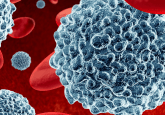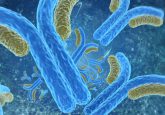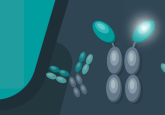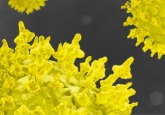Cancer cells: turning “don’t eat me” into “eat me”

Antibodies that specifically bind a protein upregulated in leukemia effectively treat cancer. Researchers now present new insights into how antibody types impact the potency and safety of such treatments.

Anti-CD47 antibodies ensure that cancer cells are removed by immune cells by blocking the CD47-SIRPα interaction and adding an “eat me” signal to the cancer cell. Image courtesy of Janssen Research and Development.
In acute myeloid leukemia (AML), abnormal red blood cells produced by bone marrow escape the immune system by expressing the “don’t eat me” signal CD47. Cancer researchers have now fully explored the anti-cancer activity of newly discovered CD47 blocking antibodies, giving a better picture of the strengths and limitations of a promising leukemia treatment.
In 2009, Irving Weissman’s group at Stanford University showed that blood cancers such as leukemia highly express CD47, a protein expressed on the surface of cancer cells. Soon thereafter, Weissman, along with several others, found that blocking CD47 enhanced tumor cell elimination. “This got us really interested in CD47 in particular since it’s not just overexpressed in [blood] malignancies, but also in solid tumors,” said Christine Pietsch from Janssen Research and Development, first author of a new study published in Blood Cancer Journal (1).
CD47 interacts with the SIRPα receptor on immune cells that identify which cells are healthy and which cells need to be phagocytosed—or removed—to protect the organism. “If you block the CD47-SIRPα interaction, you can enhance phagocytosis of cancer cells. Antibodies are a great way to target the interaction,” said Pietsch.
Pietsch and her team first found three new antibodies that effectively inhibit the CD47- SIRPα interaction and increase phagocytosis. Next, they determined how well the new antibodies targeted CD47 by placing the new antibodies in functionally different antibody backbones: an effector function competent backbone and an effector function silent backbone. An effector function competent backbone removes cancer cells by recruiting more immune cells to the cancer site in addition to blocking the CD47- SIRPα interaction whereas an effector function silent backbone only blocks CD47- SIRPα.
Using in vitro phagocytosis assays and mouse studies, the researchers determined the anti-leukemic activity for each version of the antibodies. “For full anti-tumor activity, you need the blocking function of CD47- SIRPα in addition to effector function of an antibody. The antibody adds an ‘eat me’ signal that then drives phagocytosis,” said Pietsch. “Simply blocking the interaction is not enough.”
An effector function competent CD47 antibody that potently removes leukemia cells provides compelling evidence for developing a powerful cancer therapy. However, according to Pietsch, obtaining a high drug efficacy while maintaining safety is the greatest challenge for any drug development. Indeed, treating cynomolgus monkeys with the effector function competent antibodies showed a substantial drop in red blood cell count not seen with effector function silent antibodies.
The loss of red blood cells indicates that anti-CD47 antibodies may need to be combined with other treatments to overcome some of the safety challenges. But the researchers are optimistic about developing the antibody for treating leukemia as well as other cancers with high levels of CD47.





